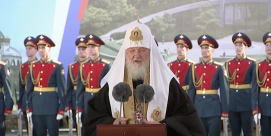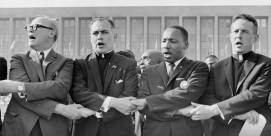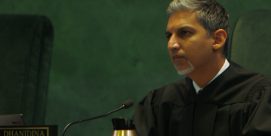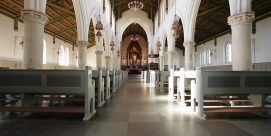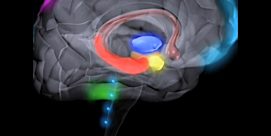KIM LAWTON, correspondent: Over the last two decades, we’ve covered some major shifts across America’s religious landscape. When we first went on the air, the big religion demographics story had been the so-called “mainline decline”--the significant loss of members in denominations that had long been considered the religious establishment. Interfaith dialogue usually consisted of Christians and Jews getting together.
 One of the biggest changes since then has been a rising recognition of America’s complex religious diversity. In 2012, the Pew Research Center announced that while the US remains a majority Christian nation, for the first time ever, the share of Protestant Christians dropped below 50%. About 70 percent of Americans overall are Christians, but the number of Americans who are part of non-Christian faiths, especially Muslims and Hindus, continues to rise.
One of the biggest changes since then has been a rising recognition of America’s complex religious diversity. In 2012, the Pew Research Center announced that while the US remains a majority Christian nation, for the first time ever, the share of Protestant Christians dropped below 50%. About 70 percent of Americans overall are Christians, but the number of Americans who are part of non-Christian faiths, especially Muslims and Hindus, continues to rise.
There are now many new projects for people of faith to get to know each other across religious lines. Previously, such organized efforts often happened among theologians and religious leaders only. More and more, it’s taking place at the grassroots. At one time, many participants would have named evangelism as the sole motivation for interfaith interactions. Now, we’ve increasingly heard that mutual understanding is a goal, even among those who may still ultimately hope to convert others to their faith.
We’ve seen many broad-based religious coalitions develop to advocate on a host of issues, including poverty, the environment, racial injustice, human rights, anti-religious bigotry and a big one recently, supporting immigration and the resettlement of refugees.
CARDINAL DONALD WUERL, Archdiocese of Washington: We talk about how we are all brothers and sisters, that we form one human family, and all of this grows out of all the religious traditions that you see around us.
 LAWTON: Another key demographic change has been the dramatic rise of the religiously-unaffiliated, the so-called “nones.” That’s N-o-n-e-s. Today, more than 20 percent of all Americans say they do not identify with any particular religion. And the drop in affiliation is especially evident among young adults.
LAWTON: Another key demographic change has been the dramatic rise of the religiously-unaffiliated, the so-called “nones.” That’s N-o-n-e-s. Today, more than 20 percent of all Americans say they do not identify with any particular religion. And the drop in affiliation is especially evident among young adults.
GREG SMITH, Pew Research Center: About one-third of all American adults under the age of 30 describe themselves as either atheists or agnostics or say they just don’t have any particular religion. And that large number is a big part of what’s driving the overall growth in this population.
LAWTON: Experts cite many reasons for the rise of the nones: among them, the growing secularization of American culture, and the widening social acceptability for people to admit they’re just not all that into religion. The clergy sex abuse scandal in the Catholic Church, the strong political focus of many religious groups and other institutional problems may have also played a role.
DIANA BUTLER BASS (Author, Christianity After Religion): They look at these institutions and they see people who are more concerned about politics, more concerned about money, more concerned about their own power, and that’s just not what people expect out of a faith  institution. They expect some level of authenticity, especially in the leadership.
institution. They expect some level of authenticity, especially in the leadership.
LAWTON: The unaffiliated trend has forced religious institutions across the board to take a new look at themselves, what they prioritize, how they come across in public, how they retain people who are part of their traditions, how they reach out to young people and how they need to broaden their appeal.
But we also discovered that being unaffiliated doesn’t necessarily mean absolute atheism. In a joint survey that our program conducted with the Pew Research Center, we found that many of the unaffiliated are religious or spiritual in some way. Two-thirds of them said they believe in God, more than a third classified themselves as “spiritual” but not “religious” and one-in-five said they do pray every day.
One institution in particular, the Roman Catholic Church, has experienced several significant transitions over the last 20 years.
BOB ABERNETHY: Our top story this week is the death of Mother Teresa. While the world was still mourning the death of Princess Diana came the sad news that the beloved Roman Catholic nun had died Friday of a massive heart attack.
 LAWTON: On our very first episode of Religion & Ethics, we reported the death of Mother Teresa, now Saint Teresa of Calcutta. Pope John Paul the Second—now Saint John Paul the Second--was still a popular leader and though getting older, still traveling the globe. I covered several of his trips, including his historic visit to the Holy Land in 2000. His death in 2005 and the election of Benedict the XVI ushered in a new era for the Church. In 2013, Benedict stunned the world by becoming the first pope in 600 years to resign. He cited his age and health. Benedict’s successor, Pope Francis, has been shaking up the church and beyond with his pastoral approach and his emphasis on simplicity and poverty. Francis’s embrace of a new set of issues, from climate change to immigration, has generated praise and controversy.
LAWTON: On our very first episode of Religion & Ethics, we reported the death of Mother Teresa, now Saint Teresa of Calcutta. Pope John Paul the Second—now Saint John Paul the Second--was still a popular leader and though getting older, still traveling the globe. I covered several of his trips, including his historic visit to the Holy Land in 2000. His death in 2005 and the election of Benedict the XVI ushered in a new era for the Church. In 2013, Benedict stunned the world by becoming the first pope in 600 years to resign. He cited his age and health. Benedict’s successor, Pope Francis, has been shaking up the church and beyond with his pastoral approach and his emphasis on simplicity and poverty. Francis’s embrace of a new set of issues, from climate change to immigration, has generated praise and controversy.
In the summer of 2001, I was working on a story about how American Muslims were trying to organize politically and have a stronger public voice. Then came the September 11 attacks, and things changed profoundly for that community.
After the attacks, President Bush said repeatedly that America was not at war with Islam.
PRES. GEORGE W. BUSH: The face of terror is not the true faith of Islam. That’s not what Islam is all about. Islam is peace.
 LAWTON: But many US Muslims reported a backlash of discrimination and harassment. Sikhs who were mistaken for Muslims also reported hate crimes against them. Many Muslims were forced out of their minority enclaves to condemn terrorism and try to explain their beliefs. Ironically, the questions and concerns inspired new interfaith solidarity with Muslims as well. Amid heightened suspicions and government surveillance, some Muslim groups launched their own projects to combat violent extremism.
LAWTON: But many US Muslims reported a backlash of discrimination and harassment. Sikhs who were mistaken for Muslims also reported hate crimes against them. Many Muslims were forced out of their minority enclaves to condemn terrorism and try to explain their beliefs. Ironically, the questions and concerns inspired new interfaith solidarity with Muslims as well. Amid heightened suspicions and government surveillance, some Muslim groups launched their own projects to combat violent extremism.
HODA HAWA, Muslim Public Affairs Council: It’s about preserving human rights, dignity, justice. And so what we’ve seen is that Muslims now are taking back that narrative.
LAWTON: The debates ramped up during the 2016 presidential campaign season with calls for Muslim registries and bans. Muslims have been very outspoken against President Trump’s temporary ban on travel from seven predominantly Muslim countries. People of many religious traditions are supporting them.
 With growing diversity and the lessening influence of institutional religion, many faith groups have found themselves in the midst of serious new culture clashes. The widening social acceptance of LGBT issues and the eventual legalization of same-sex marriage have had major implications for many religious denominations. We covered divisions in The Episcopal Church after the 2003 consecration of Gene Robinson as the nation’s first openly gay bishop. Disagreements about the authority and interpretation of Scripture brought the Episcopal Church and the entire worldwide Anglican Communion to the brink of schism. Other denominations have faced fierce theological debates over the issues as well, many still not resolved.
With growing diversity and the lessening influence of institutional religion, many faith groups have found themselves in the midst of serious new culture clashes. The widening social acceptance of LGBT issues and the eventual legalization of same-sex marriage have had major implications for many religious denominations. We covered divisions in The Episcopal Church after the 2003 consecration of Gene Robinson as the nation’s first openly gay bishop. Disagreements about the authority and interpretation of Scripture brought the Episcopal Church and the entire worldwide Anglican Communion to the brink of schism. Other denominations have faced fierce theological debates over the issues as well, many still not resolved.
MARK TOOLEY, Institute on Religion & Democracy: The church shouldn’t just go along with what the wider society demands of it.
REV. JENNIFER WEGTER-McNELLY, Church of the Covenant: Our call to be inclusive of all people comes from Scripture. It comes from faithfulness to God.
LAWTON: Evangelical and Catholic churches which have not changed their positions on homosexuality have also come under increasing pressure to re-examine their practices and be more inclusive of LBGT people.
Meanwhile, new conflicts have arisen over the boundaries of religious freedom in the public sphere. What happens when civil rights seem to bump up against religious rights? To what extent can faith-based non-profits and businesses-owners deny services because of their beliefs? Sexuality issues and the contraception mandate in the Affordable Care Act spawned a host of court cases that are still trying to sort out thorny new church-state questions.
 Those are just a few of the many changes I’ve covered for this program. But something that hasn’t changed in 20 years is that people are still living out their faith day to day in so many different ways.
Those are just a few of the many changes I’ve covered for this program. But something that hasn’t changed in 20 years is that people are still living out their faith day to day in so many different ways.
One is by helping others, especially in crisis situations. I’ve been privileged to see this firsthand, time and time again: from the teams of volunteers who poured into New Orleans to help after Hurricane Katrina, religious groups working in Haiti after the devastating 2010 earthquake and faith-based humanitarian workers delivering desperately-needed aid to refugee camps and war zones. Across the US and around the world, I’ve witnessed the many ways people worship, express their spirituality, seek the sacred and build community. The perseverance of faith and hope, even in the most difficult circumstances, continues to inspire me. I’m Kim Lawton.

 One of the biggest changes since then has been a rising recognition of America’s complex religious diversity. In 2012, the Pew Research Center announced that while the US remains a majority Christian nation, for the first time ever, the share of Protestant Christians dropped below 50%. About 70 percent of Americans overall are Christians, but the number of Americans who are part of non-Christian faiths, especially Muslims and Hindus, continues to rise.
One of the biggest changes since then has been a rising recognition of America’s complex religious diversity. In 2012, the Pew Research Center announced that while the US remains a majority Christian nation, for the first time ever, the share of Protestant Christians dropped below 50%. About 70 percent of Americans overall are Christians, but the number of Americans who are part of non-Christian faiths, especially Muslims and Hindus, continues to rise. LAWTON: Another key demographic change has been the dramatic rise of the religiously-unaffiliated, the so-called “nones.” That’s N-o-n-e-s. Today, more than 20 percent of all Americans say they do not identify with any particular religion. And the drop in affiliation is especially evident among young adults.
LAWTON: Another key demographic change has been the dramatic rise of the religiously-unaffiliated, the so-called “nones.” That’s N-o-n-e-s. Today, more than 20 percent of all Americans say they do not identify with any particular religion. And the drop in affiliation is especially evident among young adults. institution. They expect some level of authenticity, especially in the leadership.
institution. They expect some level of authenticity, especially in the leadership. LAWTON: On our very first episode of Religion & Ethics, we reported the death of Mother Teresa, now Saint Teresa of Calcutta. Pope John Paul the Second—now Saint John Paul the Second--was still a popular leader and though getting older, still traveling the globe. I covered several of his trips, including his historic visit to the Holy Land in 2000. His death in 2005 and the election of Benedict the XVI ushered in a new era for the Church. In 2013, Benedict stunned the world by becoming the first pope in 600 years to resign. He cited his age and health. Benedict’s successor, Pope Francis, has been shaking up the church and beyond with his pastoral approach and his emphasis on simplicity and poverty. Francis’s embrace of a new set of issues, from climate change to immigration, has generated praise and controversy.
LAWTON: On our very first episode of Religion & Ethics, we reported the death of Mother Teresa, now Saint Teresa of Calcutta. Pope John Paul the Second—now Saint John Paul the Second--was still a popular leader and though getting older, still traveling the globe. I covered several of his trips, including his historic visit to the Holy Land in 2000. His death in 2005 and the election of Benedict the XVI ushered in a new era for the Church. In 2013, Benedict stunned the world by becoming the first pope in 600 years to resign. He cited his age and health. Benedict’s successor, Pope Francis, has been shaking up the church and beyond with his pastoral approach and his emphasis on simplicity and poverty. Francis’s embrace of a new set of issues, from climate change to immigration, has generated praise and controversy. LAWTON: But many US Muslims reported a backlash of discrimination and harassment. Sikhs who were mistaken for Muslims also reported hate crimes against them. Many Muslims were forced out of their minority enclaves to condemn terrorism and try to explain their beliefs. Ironically, the questions and concerns inspired new interfaith solidarity with Muslims as well. Amid heightened suspicions and government surveillance, some Muslim groups launched their own projects to combat violent extremism.
LAWTON: But many US Muslims reported a backlash of discrimination and harassment. Sikhs who were mistaken for Muslims also reported hate crimes against them. Many Muslims were forced out of their minority enclaves to condemn terrorism and try to explain their beliefs. Ironically, the questions and concerns inspired new interfaith solidarity with Muslims as well. Amid heightened suspicions and government surveillance, some Muslim groups launched their own projects to combat violent extremism. With growing diversity and the lessening influence of institutional religion, many faith groups have found themselves in the midst of serious new culture clashes. The widening social acceptance of LGBT issues and the eventual legalization of same-sex marriage have had major implications for many religious denominations. We covered divisions in The Episcopal Church after the 2003 consecration of Gene Robinson as the nation’s first openly gay bishop. Disagreements about the authority and interpretation of Scripture brought the Episcopal Church and the entire worldwide Anglican Communion to the brink of schism. Other denominations have faced fierce theological debates over the issues as well, many still not resolved.
With growing diversity and the lessening influence of institutional religion, many faith groups have found themselves in the midst of serious new culture clashes. The widening social acceptance of LGBT issues and the eventual legalization of same-sex marriage have had major implications for many religious denominations. We covered divisions in The Episcopal Church after the 2003 consecration of Gene Robinson as the nation’s first openly gay bishop. Disagreements about the authority and interpretation of Scripture brought the Episcopal Church and the entire worldwide Anglican Communion to the brink of schism. Other denominations have faced fierce theological debates over the issues as well, many still not resolved. Those are just a few of the many changes I’ve covered for this program. But something that hasn’t changed in 20 years is that people are still living out their faith day to day in so many different ways.
Those are just a few of the many changes I’ve covered for this program. But something that hasn’t changed in 20 years is that people are still living out their faith day to day in so many different ways.